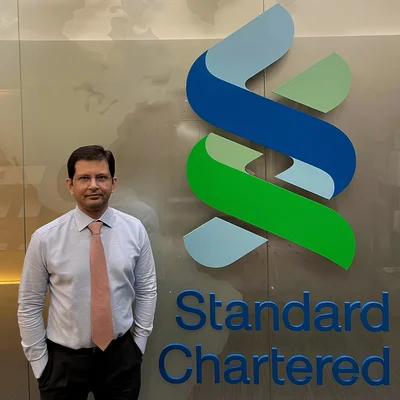
Currency derivatives house of the year: Standard Chartered
Asia Risk Awards 2021

For Asia-Pacific’s foreign exchange markets, the past year could be described as the calm after the storm. Following a spell of sharp price movements and heavy trading across most currency pairs at the start of 2020, currency markets have returned to their sleepy, subdued pre-pandemic state.
“We’re back to the regime we were facing in the FX space before the Covid-19 crisis – no volatility; no direction; swap points and carry being completely compressed,” says Mathieu Lépinay, global head of macro structuring public side at Standard Chartered. “So the whole challenge was to see how we could emerge from this situation with ideas and solutions to suit what our clients are looking for. That, I would say, has been the key driver for our business over the past one year.”
With a lack of discernible market trends to trade on, Standard Chartered instead made use of its understanding of regulations and liquidity conditions in the region’s currency markets to come up with new ideas for optimal and cost-efficient hedging solutions for corporate clients.
The bank’s efforts to build up its exotics trading capabilities has also contributed to the success of its corporate solutions business, allowing for risk generated by corporate flows to be recycled through volatility and correlation products traded with the hedge fund community.
It is striking, says Lépinay, that in a year when currency volatility has been so muted, the bank’s onshore revenues for FX options are actually already larger than what was recorded last year. In addition, significant volumes of volatility swaps, variance swaps and dual-digital option products on a range of Asian currencies have been traded over the past year, he adds.
“With the lack of currency vol in the past year that just shows we’ve expanded in terms of our products and client sets and had a serious focus toward this region,” he says.
In addition, Standard Chartered is also continuing to make big strides in the roll-out out of new environmental, social and governance (ESG) products within its derivatives offering in Asia. At the start of the year, the bank launched ESG-linked FX forwards. The product was also a milestone in Korea, as the first ESG-linked hedging products for the Korean won currency and thereby setting a precedent for future ESG transactions in the market.
A choice of curves
One of Standard Chartered’s key strengths in currency derivatives has long been its ability to devise solutions that take advantage of the fast-changing regulatory landscape around Asian currencies. In restricted currencies such as Chinese renminbi or Indian rupee, the existence of onshore and offshore currency rates offers scope for innovation in the design and delivery of such solutions.
“In all these currencies you have two or three markets,” says Lépinay. “You have the onshore market, the offshore market and, in some cases like China, you have the CNH market as well. And the more markets [there are], the more flexibility you have, and the better you can optimise hedging solutions for clients.”
A hedging solution devised for a non-resident client operating in India in the past year is one example of this. Standard Chartered’s corporate client was looking to hedge a USD/INR exposure stemming from the capital repatriation of its onshore entity, and required a deliverable INR payoff on the transaction. The hedging facility could be extended to the client on a secured basis only. However, as a non-resident, the client had only offshore assets at its disposal to offer Standard Chartered as security.
With the lack of currency vol in the past year that just shows we’ve expanded in terms of our products and client sets and had a serious focus toward this region
Mathieu Lépinay, Standard Chartered
And, given that the FX regulatory framework in India does not provide explicit permission for a bank in India to provide hedging facilities to non-residents by securing against offshore security, the client would have to face an offshore branch of Standard Chartered Bank.
Standard Chartered was quick to rely on a relaxation of the Reserve Bank of India’s rules on FX transactions that came into effect in September 2020, which allowed non-residents to trade on a back-to-back basis with SCB India through an SCB offshore entity. This was not permitted for foreign exchange hedging transactions under the previous regime.
“That is how we managed to create what we think was the first back-to-back trade where our client was facing an offshore branch of the bank on an onshore INR deliverable transaction,” says Lépinay. “We joined what the regulation allows you to do with the exact type of hedge to satisfy our client. It shows how quick we are to adapt to new market and regulatory developments.”

A hedging solution for a corporate in the Philippines serves as another example of how the bank uses its understanding of the regulatory environment to design and deliver the most optimal hedge for clients.
The corporate was looking to hedge FX risks arising from the mismatch between its USD bond holdings and Philippine peso proceeds, and required fully deliverable flows.
Due to high carry costs, however, it was unfavourable for the client to hedge via a vanilla forward transaction linked to the onshore USD/PHP curve. Standard Chartered undertook an in-depth analysis of the client’s exposure and the historical movements of various USD/PHP parameters, both onshore and offshore to determine a hedging solution that could both improve hedging efficiency and reduce costs for the client. On the back of this analysis, the bank delivered a solution that utilises what they describe as an offshore deliverable curve.
Essentially, the client executed a three-year USD/PHP option-based strategy that took advantage of heightened volatility and carry in the offshore market, but in a deliverable format.
“Of course, it is not like we have an infinite appetite for Hong-Kong dollar vega,” says Lépinay. “But thanks to our franchise in USD/HKD, we are able to attract both investor interest and corporate interest and match them up the best we can. It lets both sides enter at a very good point and allows us to hedge our risk in a sensible manner as well.”
“Again, you can only do this if you understand, from a regulatory perspective, what is allowed in terms of cross-border transactions and in terms of the product offering,” he adds.
Generating value
One of the reasons Standard Chartered is able to deliver solutions like these to corporate clients is its ability to shift the risk generated to hedge funds and asset managers via its exotic product suite.
The bank’s capacity to generate and recycle large sized risk in Asian currency pairs is demonstrated by an option-based hedge solution delivered an asset manager in Hong Kong earlier this year.
The asset manager faced a FX mismatch resulting from a Hong Kong dollar balance sheet and a US dollar liability. A balance sheet hedge had been executed by the client in March 2020, through a series of one-year USD/HKD capped forwards, an options-based strategy that involves buying a synthetic currency forward while simultaneously buying another option.
This allowed the client to hedge at 7.75, the lower bound of HKD peg to USD, while selling top side calls at 7.85, the upper bound of the currency peg.
That trade was rightly recognised by the Asia Risk Awards in 2020, but the way in which it was restructured earlier with an extended tenor and increased notional was even more impressive.
Since that initial hedge, the client had continued to add more USD liability, some of which was at a longer duration, to its balance sheet. As a result, the client was looking to extend both the size and tenor of its USD/HKD capped forward transaction with Standard Chartered.
The bank proposed to restructure the original one-year USD/HKD capped forward to an 18-month USD/HKD capped forward with an increased size of US$4 billion.
In order to entertain a trade of such size and tenor, Standard Chartered had to be confident it could transfer some of the risk to minimise the amount that would need to be warehoused.
That meant identifying potential counterparties to take the other side. Typically, Lépinay says, these would be equity-based portfolios seeking cheap options hedges or long-term investors willing to buy vol outright or via call spreads as a cheap play on volatility.
So while the bank was advising the asset manager on best execution for the capped forward trade, it was simultaneously beginning discussions with investors that might be willing to take the other side.
“Of course, it is not like we have an infinite appetite for Hong Kong dollar vega,” says Lépinay. “But because of our franchise in USD/HKD, we are able to attract both investor interest and corporate interest and match them up the best we can. It lets both sides enter at a very good point and allows us to hedge our risk in a sensible manner as well.”
Lépinay says the trade fits very well into what has been the story of the year, which is where to extract value from. “It shows that, even when it is a pegged currency like Hong Kong dollar, we managed to find a solution and bring that to our clients,” he says.
Only users who have a paid subscription or are part of a corporate subscription are able to print or copy content.
To access these options, along with all other subscription benefits, please contact info@risk.net or view our subscription options here: http://subscriptions.risk.net/subscribe
You are currently unable to print this content. Please contact info@risk.net to find out more.
You are currently unable to copy this content. Please contact info@risk.net to find out more.
Copyright Infopro Digital Limited. All rights reserved.
As outlined in our terms and conditions, https://www.infopro-digital.com/terms-and-conditions/subscriptions/ (point 2.4), printing is limited to a single copy.
If you would like to purchase additional rights please email info@risk.net
Copyright Infopro Digital Limited. All rights reserved.
You may share this content using our article tools. As outlined in our terms and conditions, https://www.infopro-digital.com/terms-and-conditions/subscriptions/ (clause 2.4), an Authorised User may only make one copy of the materials for their own personal use. You must also comply with the restrictions in clause 2.5.
If you would like to purchase additional rights please email info@risk.net
More on Awards
Clearing house of the year: LCH
Risk Awards 2025: LCH outshines rivals in its commitment to innovation and co-operation with clearing members
Best use of machine learning/AI: CompatibL
CompatibL’s groundbreaking use of LLMs for automated trade entry earned the Best use of machine learning/AI award at the 2025 Risk Markets Technology Awards, redefining speed and reliability in what-if analytics
Markets Technology Awards 2025 winners’ review
Vendors jockeying for position in this year’s MTAs, as banks and regulators take aim at counterparty blind spots
Equity derivatives house of the year: Bank of America
Risk Awards 2025: Bank gains plaudits – and profits – with enhanced product range, including new variants of short-vol structures and equity dispersion
Law firm of the year: Linklaters
Risk Awards 2025: Law firm’s work helped buttress markets for credit derivatives, clearing and digital assets
Derivatives house of the year: UBS
Risk Awards 2025: Mega-merger expected to add $1 billion to markets revenues, via 30 integration projects
Interest rate derivatives house of the year: JP Morgan
Risk Awards 2025: Steepener hedges and Spire novations helped clients navigate shifting rates regime
Currency derivatives house of the year: UBS
Risk Awards 2025: Access to wealth management client base helped Swiss bank to recycle volatility and provide accurate pricing for a range of FX structures







